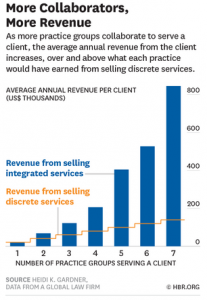I first started talking to accounting firms about growth strategies in 1982 when I was just a kid. One of the things I noticed even then was that multi-partner, multi-manager firms that embraced a “whole firm” approach to meeting client service needs seemed to grow further faster than those built on an “eat what you kill” approach.
I experienced a sense of deja vu when I picked up and read an article in the March, 2015 edition of the Harvard Business Review by Heidi Gardner titled When Senior Managers Won’t Collaborate.
The article talks to research she has done on large professional service firms that have a global presence and in that sense does not relate specifically to the people I hang out with in our profession.
However, I believe from my own observation and experience that the conclusions she draws apply to small, and certainly mid-sized, firms as well.
Her big message is that firms which have strong collaborative service models enjoy significantly higher revenue growth BUT the challenge many firms face that “for the professionals involved, the financial benefits of collaboration accrue slowly and other advantages are hard to quantify.”
 The benefits to the firm from collaboration include:
The benefits to the firm from collaboration include:
Greater average annual revenue (see figure) from clients who are served by more than one group
Clients tend to see single-specialty service as a commodity – i.e. they could get it from any equivalent firm and the lowest price wins but multi-disciplinary service is clearly more complex and commands a higher price.
The more partners who service a client the more likely it is that client will remain loyal to the firm irrespective to changes in a partner’s situation.
At an individual level the main benefit to a collaborator is more work for their own clients as a result of referrals from their colleagues who better understand their personality and skill set. On average, she found, that partners got “a new client referral within a year from one in every six colleagues they teamed up with.” She points out that doesn’t seem much but the cumulative effect over time not to mention the internal word of mouth about a person’s skill yield bit returns to the individual as well as the firm.
The individual also benefits from the learning experience that comes out of a collaborative project which can then be applied to lifting the value brought to his/her own clients e.g. seeing a challenge through a different lens, learning a new and better way to communicate with a client or pitch a proposal … the learning opportunities from working outside your familiar domain are endless.
An immediate benefit to the firm (and to the individual if a reward system is appropriately designed) is greater clarity of opportunity to identify additional value adding services to your own clients by having more familiarity with what your colleagues do and the value they can create. This gives you more confidence to introduce your clients to those service opportunities and to the partner who drives them.
Gardner highlights the fact that the biggest barrier to embracing a firm-wide collaborative mindset is the compensation process. There in no doubt in my mind that this is THE major issue and is the reason why, when I was in practice, we had a compensation system that was tied largely to firm-wide performance. If you’re interested, let me know and I’ll shoot you a White Paper I wrote called Compensation and Firm Strategy.
If you are rewarded by the relative size of your “book of business”, or your “billable hours”, or your “new client growth” there is little incentive to direct work to other partners. What would you want to make them look like great producers if you’re doing the initial leg work to bring work into the firm.
Sadly there could be many losers. For example they might include the client (missed out on the value add), the firm (missed out on the revenue and perhaps even loses the client), the referring partner (because s/he presumably has some compensation tied to firm-wide results and is likely to miss out on a reciprocal referral), referee partner (because s/he does not get to do the work), team members (who would have gained experience on the job), the firm (because client loyalty may be eroded) …. the list goes on.
